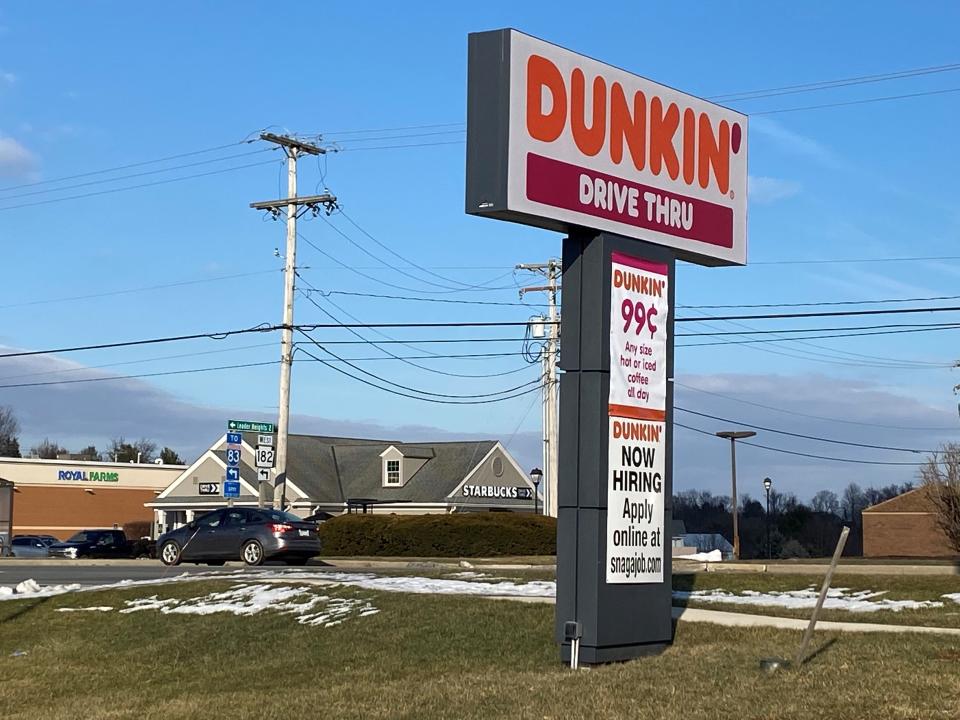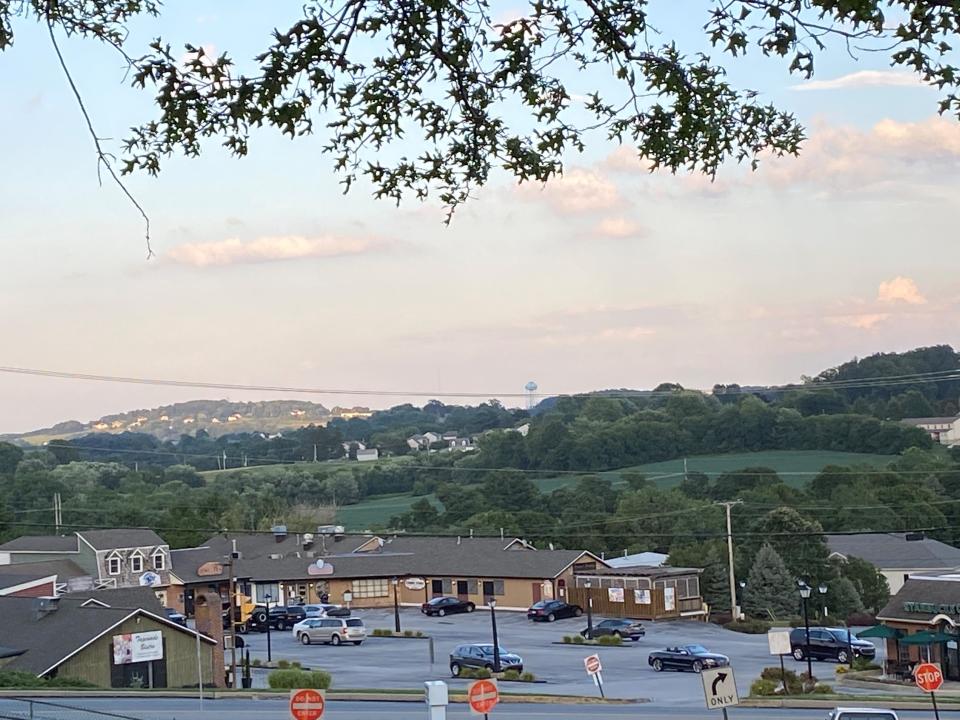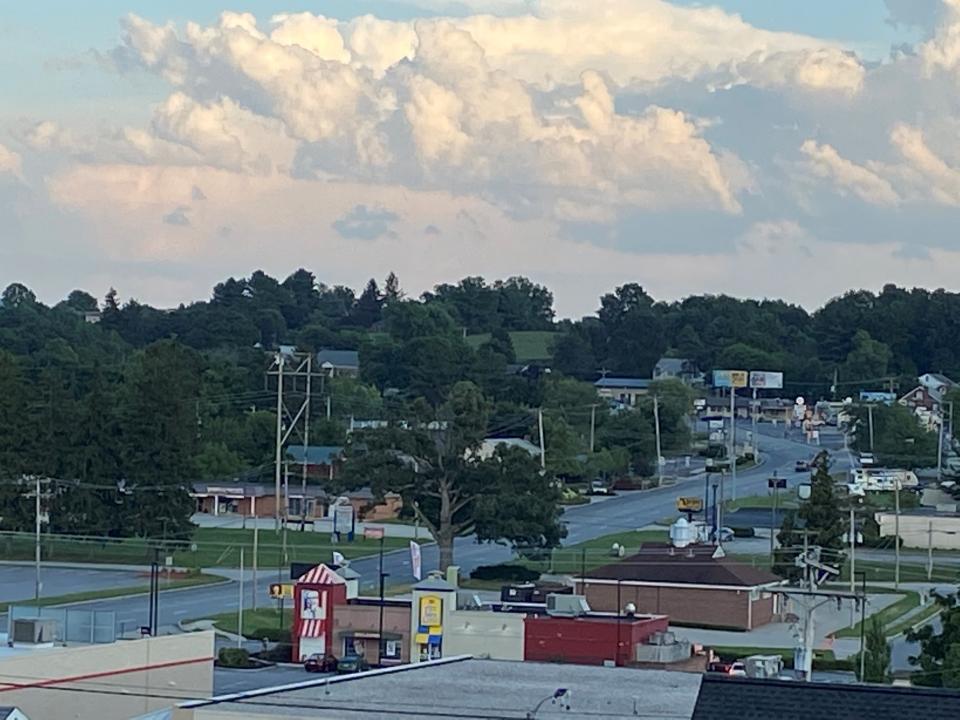York Township’s village of Spry is changing in real time
In the past two years, Dunkin’ opened in a rehabbed bank building along Route 74 in the York Township village of Spry.
The national coffee-and-doughnut chain greeted customers with streaming banners and steaming brew, and vehicles soon found its drive-thru, tailor-made for life in a pandemic.
On its grounds, a centuries-old signature oak stands, reminding everyone that this was once rich forest and farmland, now covered over by the suburban sprawl that fans from the tree in every direction as far as the eye can see.

Then just the other day, Starbucks opened a shop 100 yards from its previous store in another rehabbed bank building. It operates just about across the street from Dunkin’. The vault came out, and the bank’s former drive-thru handed out Starbuck Grandes instead of cash.
So in this piece of once-rural York County, two coffee shops are squaring off in a village long considered York Township’s center.
And these national brand shops are doing battle in about the geographical center of the 900-plus-square-mile county. What does that say about what is happening in York County?
York County is changing before our eyes.
Some of the change is bad for quality of life: sprawl featuring chain businesses, subdivisions on big lots and cookie-cutter apartments. And some change is for the better: a population that is becoming more diverse by the year.
Spry destined to grow
The village of Spry cropped up along a superhighway of its day — a day that goes back to before the county’s beginning in 1749. The village straddles the old York and Peach Bottom Road, now South Queen Street or Route 74, a vital road for settlers.
Travelers would move from the port of New Castle, Delaware, and then across southern Lancaster County. They’d cross the Susquehanna on ferries and then travel from southeastern York County on the York and Peach Bottom Road through York Township and Spry to York.
At some point, the road was tolled and a tollgate operated at the southern foot of Spry’s major hill, a shopping center now known as Toll Gate Village.

The village was destined to grow as the first real settlement between York and Dallastown on the pike. On the village’s western flank, another well-used north/south road carried wagons and other travelers from York to Joppa and then Baltimore: the Joppa Road, now the Susquehanna Trail. So sandwiched between these two routes, Spry would grow.
During and after the Civil War, Innersville, as Spry was originally called, hosted cigar factories and businesses supporting travelers on the pike.
The story is that Innersville became Spry after government officials in the late 1800s sought to end confusion with another Pennsylvania town so named.
One resident came into William Conway’s store and advised its owner, a former postmaster: “You better be spry about it.”
Conway replied, “That’s the name, Spry.”
The village needed to live up to its name because the trolley line came through in 1902, sparking growth and giving townspeople easy access to York’s factories.
The trolley went out in the late 1930s, but 20 years later, a major transportation artery came in that would accelerate change in Spry to this day.
And prompt national coffee chains to open new stories in the early 2020s.
Village’s borders undefined
That game-changing major transportation route, of course, was Interstate 83.
But before we look at this superhighway, 1950s style, we should define the limits of Spry. Or attempt to, because a 2003 history of York Township struggled to set its boundaries.
“Even some of the residents,” the history states, “are not certain exactly where the town begins and ends.”
Old-time residents say “Old Spry” commenced in the north at Spurg’s or Nick’s diner, since demolished, and ends at the foot of the hill on which York Township Elementary sits. But the hill has two feet, north and south. And maybe two more if you think east and west.
“New Spry,” according to the history, runs from Square Deal Garage to Alberto’s Pizza and the since demolished Mack’s Ice Cream’s original location.

Signage, then new, declares that Spry begins at Commerce Bank, now First National near the interstate’s interchange, to the old Burger King. That’s now Dallastown Family Restaurant, which serves Mack’s Ice Cream.
The point is that Spry has sprawled outward with the opening of the interstate, with residents seeking homes with easy access to Baltimore 50 miles away and businesses seeking to service those residents. Meanwhile, that mighty oak at Dunkin’ stands tall as the borders shift around it.
Community in Spry
It is the increasing diversity of these residents that represents the positive part of a changing Spry and York Township. Among other things, the world is becoming diverse, and York Township’s hosting of a population with different backgrounds means its people can better confront this world.
For example, about 10% of the township’s population was Black, Latino and other nonwhite people in 2010. The 2020 census shows the minority population increased to 17%.
The population growth in York Township in the past decade is indicative of the increase in Black population in the I-83 corridor serving Baltimore and Harrisburg commuters, urban planner David Rusk wrote in 2019.
“Most of the growth occurred in the suburban areas of Central York (many in new subdivisions in rapidly growing areas like York Township, Windsor Township, Conewago Township, and Manchester Township),” he wrote.
Two interesting examples of this growing diversity in the Spry area are evident. In the early 1960s, William and Daisy Myers, who initially faced racial discrimination in Bucks County’s Levittown, found their decades-long dream home in the Arlington Heights subdivision in Spry.
And Spry Church-Pine Grove Campus hosts a sign on its lawn telling of ministries offered by York Gospel Assembly, a Haitian gathering. So in that one area of the township, this ministry joins a diverse group of congregations: United Methodists at Spry Church, Annunciation Greek Orthodox Church and Freedom Biker Church, a Christian brotherhood of motorcycle riders.
Community also is evidenced cross town in the eastern end of Spry, on or near the Spry Church-School Street campus. The church stands at one angle of an intersection. The Boy Scouts Troop 50 meet in a next-door building.
Across the street, The Link Community Youth Center’s building hosts other clubs. One November evening in 2021, the York Women’s Association celebrated its 80th anniversary. That same evening, the church and Boy Scout buildings were lit up and bustling.
Community, thus, still exists in Spry amid the impersonality of major roads and national chains.

Changing in real time
The former bank buildings in which Dunkin’ and Starbucks operate today are themselves indicators of change.
The busy customers who use their drive-thrus for a cup of Joe to brace them in their early morning commutes to Hunt Valley also are gone from the community during customary banking hours. And banking means contact, avoided by many in a pandemic.
No matter. The coffee customers just do their banking online, so not as many of those expensive buildings are needed for banking.
These motorists are a growth group in Spry. The York Township history takes note of such travelers: “Driving south on Queen Street, one might pass through Spry without notice.” That tendency might still be true today, as the chains and sprawl have homogenized this once bucolic area.
What the township history says about small business in Spry applies to the chains: “Small business had a way of coming and going, but always being around.”
But just because Spry can be passed through unnoticed does not mean that the village should be overlooked.
Spry, whatever its boundaries and still holding the beauty and promise of that big oak, serves as an example of how York County is changing in real time.
Upcoming presentations
I will be presenting on these continuing education topics in OLLI at Penn State York’s Spring Semester: “Religion in York County: A Complex and Influential Piece of our Past”; “After the Civil War: York County’s People and the Coming Industrial Revolution”; and “Articles of Confederation: Stronger than a Rope of Sand.” Times and dates: https://olli.psu.edu/york/courses/.
Jim McClure is the retired editor of the York Daily Record and has authored or co-authored eight books on York County history. Reach him at jimmcclure21@outlook.com.
This article originally appeared on York Daily Record: York Township’s village of Spry is changing in real time

